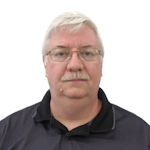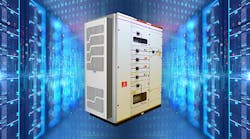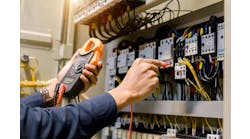In Illinois this year we have had the hottest summer on record. While this might have been great news for those of us who have a pool to cool off in, it’s not great news for manufacturers who have control systems in warehouses where environmental controls are not in place. With outside temperatures approaching 100 °F, the temperature inside a building without the benefit of climate control can reach 130 °F or higher. The temperature inside a panel can climb exponentially when the main method of cooling—the surface of the electrical enclosure—is surrounded by air that is greater than the nominal energy—heat—generated within the enclosure.
Our control panels have components that, by their very nature, generate heat. Power supplies and variable-frequency drives are the main source of heat, but every single electronic device gives off some sort of heat as a result of performing their functions. Each one of these devices contributes to the ambient heat in the enclosure. As part of a control system design, we must take this factor into consideration when choosing the enclosure that our system will occupy.
When using a metallic enclosure and back panel, the property of thermal conduction can be used to transfer heat from the components into the backplane and then to the skin of the enclosure itself. This is not a perfect method of moving heat, but it does help. To further aid in the conduction of heat, the enclosure size can be increased to not only improve the surface area over which the heat can be exchanged but also increase the free air space inside the panel. Air currents are generated inside an enclosure, and this air passes over and through components to help aid in moving heat away from the components.
Not all enclosures are metallic, so, in addition to the consideration of free air space and thermal conduction, consideration of the movement of air inside a panel is an important part of panel design. Components that are more susceptible to higher temperatures should generally be located in the bottom of the enclosure because, as we all know, hot air rises, forcing cooler air down.
Once these concepts are employed, we need to look to other methods of reducing or controlling the temperature inside an enclosure. These considerations aren’t really that different from cooling the living space in your home. For instance, for some immediate cooling of a particular object such as yourself, you might direct a fan to move air across your body. The movement of air promotes evaporation or thermal conduction by moving the hot air off your skin and replacing it with air that is a little cooler than the air that is immediately proximate to your skin. If that method isn’t sufficient, you can create a circuit where hot air is evacuated out of the room you are in and outside air is brought back in. If further cooling is required, an air conditioner or air exchanger can be employed to remove moisture from the air inside the enclosed space. This method is based on the principle that moisture—humidity—retains heat in air. By reducing the humidity, we reduce the ability of the air to retain heat.
The equivalents of the home environment conditioning can be found in the automation realm in the guise of an enclosure air exchanger, air conditioner or a venturi-style air cooling system where compressed air is supplied to an enclosure. A thermostat controls a valve that passes the compressed air through a venturi and directs inside air back out of the enclosure through a one-way valve. This supplies clean, cool air to cool components in an enclosure.
This last principle leads us to cabinet purge systems. For control systems in hazardous environments, the choice of a cooling system becomes more important because the method employed must also make sure that the outside environmental conditions don’t get inside the enclosure. Failure to do so could result in catastrophic failure of the panel components or, worse, an explosion or fire.
[pullquote]One could design everything using explosion-proof devices, but this can be very costly. The alternative, is to design the control cabinet in a NEMA 12 or 4 category and then add a purge system to effectively create a NEMA 7 or 9 category enclosure. The components outside the control enclosure must, of course, maintain the explosion-proof rating, but the cost reduction can be significant for the control enclosures. A NEMA 7 rating, you might recall, is designed to contain an internal explosion without causing an external hazard, while a NEMA 9 rating is designed to prevent the ignition of combustible dust by eliminating the means by which dust can get inside the enclosure.
A panel purge/pressurizing system is an addition to a control system that introduces a protective (inert) gas supply to an enclosure in such a manner that it positively pressurizes the enclosure. Gas or dust can’t get in because the internal pressure of the enclosure is higher than the outside environment. For hazardous gas environments, the gas must be purged from the enclosure before pressurizing. For hazardous dust environments, the dust must be physically removed from the inside of the enclosure before closing and sealing the enclosure. At that point, the same procedures take place for both hazardous gas and hazardous dust situations. The main difference is that hazardous dust environments generally required a higher minimum pressure in the enclosure.
[javascriptSnippet ]
After purging the air present in the enclosure when the door is closed, the system applies the safe gas in such a way as to oppose any leaks caused by gaskets, doors, windows and cable glands. The pressure is monitored to ensure a minimal pressure is maintained. NFPA 496 requires an exchange of four volumes—four times the volume of the enclosure—while IEC60079-2 requires an exchange of five volumes. In both situations, an external, one-way relief vent is employed to relieve any excess pressure in the enclosure. For a dust condition, a pressure-relief device is also required because a pressure regulator could fail and allow too much pressure to exhaust to outside, creating a situation where dust could enter the enclosure through the various leak points.
In all situations, the pressure in the panel is monitored. If the pressure falls below the minimum, an action is required to remedy. The response to low pressure might be to immediately de-energize all equipment and require manual intervention to correct this issue. The response might be, instead, a visual and audible alarm prompting action from the operator. The severity of the hazard will dictate the type of prompt to this issue.
The type of protective gas, in most applications, is clean, compressed air. For some situations, an inert gas light nitrogen is used. In either situation, the supply is regulated and filtered to maintain the quality of the supply. The incoming supply must exceed the desired, maintained pressure flow rate of the system. The pressure in the system, however, should not be so high that it distorts windows, doors, gaskets or wiring glands. Care should be taken to make sure the size of the lines providing the purge/pressure system are sufficient to maintain the pressure during the most consuming part of the process, usually the purge cycle.
Most electrical enclosure manufacturers also offer purge/pressurization systems. Each vendor has worksheets that help with the correct sizing of a system. Some large-volume systems can be used for up to two separate enclosures, while low- or medium-volume systems are sized for individual enclosures only.
Ultimately, the choice to use a purge/pressurization system should consider the steady state environment of the application. If the dust or gas in the environment is highly combustible or explosive when exposed to the potential of heat or an arc, then the use of a NEMA 7 or NEMA 9 enclosure should be considered first, over the potential savings of a NEMA 12 or NEMA 4 enclosure and components. Always err on the side of caution when dealing with such environments. Keep it cool, but always keep it safe.
ALSO READ: Which enclosure fits my needs?
My apologies for my absence from Control Design’s September 2020 issue. It was my first absence in the five years that I have been a contributing editor for Control Design. As you are all aware in early spring, the world was plunged into a global pandemic, in the name of COVID-19, and that cloud still hangs over us today. Despite my steadfast adherence to the guidelines for the prevention of spread, I managed to contract COVID-19 in early August. My official diagnosis was pneumonia due to COVID-19, but, whatever the definition, I struggled for 18 days to breathe on my own. I will never underestimate the function of the lungs again. Many people suffer from COPD (my parents died from the condition after a lifetime of smoking), but until you experience the panic of not being able to breathe on your own, you can’t begin to imagine what it is like for those afflicted. I am well on the way to recovery and hope that you don’t get sucked into the self-serving, politically motivated postings on social media. Observe social distancing, and wear a mask when you can’t; and wash your hands if you have to touch something outside of your home. Remember that you are wearing the mask to protect others. My mask worked. I might have gotten COVID-19, but my family members, co-workers or friends didn’t contract the virus from me. The mask worked.






